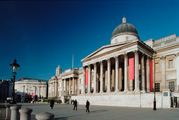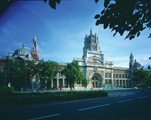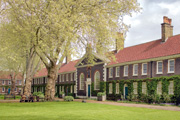British Olympic Design: 1948 – 2012
Originally published in March 2012 in American in Britain magazine
With barely four months before the 2012 Olympic Games begin, London is in the throes of final preparations. The city feels slightly frantic at the moment. It feels as if everyone is working hard to welcome visitors and athletes from all corners of the world. What must not be ignored, of course, are the years of planning and all the behind-the-scenes work done by extraordinarily gifted designers and architects working in a variety of fields.
British Olympic Design: 1948 – 2012
By Abby Cronin
With barely four months before the 2012 Olympic Games begin, London is in the throes of final preparations. The city feels slightly frantic at the moment. It feels as if everyone is working hard to welcome visitors and athletes from all corners of the world. What must not be ignored, of course, are the years of planning and all the behind-the-scenes work done by extraordinarily gifted designers and architects working in a variety of fields. We begin by looking at a few examples of their outstanding contributions. The latter part of this article will look back sixty-four years to the immediate post-war period when the 1948 Olympic ‘Austerity Games’ took place in London. Britain faced serious challenges similar to those we continue to face today. While the look of the 2012 Games may have changed, the enduring spirit and motivation of participating athletes continue to aim for ever higher levels of excellence.
Since 1936 a new torch has been designed each year to carry the flame on a journey to the host city for every Olympic Games. Soon the 2012 Olympic torch will set off on its round- the-world journey. The 2012 torch is an elegant golden tapering cone, perforated with 8000 small laser-cut holes in two aluminium skins welded together. It is truly an example of excellence in British design. When the Olympic torch sets off on its global relay from 19th May to 27th July it must meet a demanding brief. The flame will be passed on from one torchbearer to the next in order to reflect the celebratory nature of the Games. It must be light enough for 8000 people to carry it over 8000 miles. And it must reflect the Olympic motto: ‘Faster, Higher, Stronger’. Designers Jay Osgerby and Edward Baber know their torch will be watched by millions and culminate in lighting the Olympic cauldron at the opening of the Games. It embodies traditional values expressed in an iconic stylish honeycomb executed in a modern style and has been nominated as one of the highly acclaimed designs of 2012.
The brand logo of the 2012 Games welded to surface of the torch. Today this logo is an instantly recognizable emblem. But when introduced in 2007, it aroused considerable controversy. Designer Wolff Olins took nearly a year to create it at an estimated cost of £400,000. There was an unprecedented backlash with thousands signing a petition calling for it to be scrapped. Lord Coe, chairman of the London Organising Committee of the Olympic Games, came to its defence explaining that: ‘This is the vision at the very heart of our brand…’ Others defending the design regarded it as a truly innovative brand logo that captured the essence of the London 2012 Olympic Games. Those who like the logo agree that its design is somewhat dissonant but feel it reflects London as an edgy modern city. Even though the emblem contains neither sporting images nor pictures of London landmarks, it shows that the Games are more than London, more than sport; they are for everyone, regardless of age, culture and language.
When we come to view the architecture in the 2012 Olympic Park, the Olympic Velodrome deserves praise as an example of the best in British design. In October 2011 it was awarded the Prime Minister’s Better Public Building Award, a prestigious accolade. From all accounts it is a state of the art-style stadium. Architectural critics have praised it for its unusually pure form. Viewed from a distance it is a stunning organic yet geometrical structure. Inside are a swooping wooden 250- metre cycling track, 6000 seats, a cycle workshop and storage and additional facilities including a café. In keeping with its function, the building’s design concept was inspired by the efficiency of the bicycle. It boasts controlled environmental conditions and will be used after the Games when a road cycle circuit and a mountain bike course will be added. The Velodrome was the first Olympic Park venue to be completed, and Hopkins Architects and co-partners are to be congratulated for having designed and built a landmark of striking architectural beauty and function. After the Games the VeloPark will be managed by the Lee Valley Regional Park Authority and open to the public and world-class cyclists. Together with the 2012 Olympic torch, it joins the list of Best Designs of the Year 2012. A model of the Velodrome can be seen at the Design Museum until 15th July 2012.
Another outstanding architectural design for the 2012 Olympics is the Aquatic Centre by Zaha Hadid. Fifteen years ago Hadid saw that London should be developed toward the east, and the Olympic Village has been a catalyst for its regeneration. Hadid’s unique structure is featured in the Victoria and Albert’s Exhibition British Design 1948-2012: Innovation in the Modern Age, which opens 31st March. Her design is a tall, irregular building and probably too big to comprehend from the outside. The sweeping wave form of its huge roof is meant to remind spectators that the building is a homage to water. The roof appears to float like the swimmers who compete inside. It conveys a feeling of undulation which is said to be inspired by swimmers’ movements through water. Temporary wings of raked seating are detachable. The seats will be in place for spectators during the Games but will be removed afterward. Hadid remarked, ‘It was important for us to conceive the building within its setting at the entrance to the park.’ She elaborated further; explaining the ‘architectural language of fluidity and spatial complexity ensures that the Aquatics Centre retains the strongest sense of belonging to its riverside environment.’(p 348 V&A catalogue British Design from 1948: Innovation in the Modern Age. 2012)
Connections and contrasts link the 1948 ‘Austerity’ Games to the 2012 Olympics. The Austerity Olympics are described in Janie Hampton’s book as a ‘triumph of invention, thrift and improvisation that resulted in the most inexpensive and unpretentious…and friendliest and least political of all Olympics.’ The Games revealed a nation pulling together. With Britain left nearly bankrupt and struggling to recover from a world war, basic goods were rationed. The entire budget for the 1948 Games was £760,000, a stark contrast with today’s billion-pound budget, Olympic village and high-speed rail links. Such differences are hardly surprising. The main venue for the 1948 Games was the Empire Stadium – now known as Wembley Stadium. The diets of Olympians in 1948 were excessively modest by current standards. They had to train on a basic ration of a mere 2,600 calories per day. Teams from abroad brought their own supplies: the Chinese brought bamboo shoots; the Argentinians brought green tea and spaghetti. We need to be reminded that sixty years ago when women were barred from most sports; few people objected. And while the Games were held during Ramadan, Muslims were not excused from training while fasting. (1)
Overall connections between the 2012 Olympic Games and the 1948 Austerity Olympics include one which reveals a deep pride in Britain’s commitment to support global sporting competitions. In 1948 British sporting and governmental bodies mustered the famous ‘spirit of the Blitz’ to organise the Games, working with minimal resources. The Games began on 29 July 1948 with King George VI presiding over the opening ceremony in the presence of more than 80,000 spectators. By contrast, when the 2012 Olympic torch sets the cauldron alight at the opening ceremony on Friday 27th July, the spectacle will be broadcast worldwide, giving billions of viewers ‘front-row seats’. Only then will we be able to grasp how remarkably creative and innovative the behind-the-scenes designers and architects have been. The 2012 Olympics will be a momentous occasion for everyone involved, from the drawing board, to Londoners and to the world.
_______________________________________________________________
NOTES:
1. Hampton, Janie. The Austerity Olympics: When the Games Came to London in 1948. 2008 Introduction
EXHIBITIONS:
1. Design Museum. Designs of the Year 2012. February 8th 2012 – 15th July 2012. www.designmusuem.org
2. Victoria & Albert Museum. British Design 1948 – 2012: Innovation in the Modern Age
31st March 2012 – 12th August 2012. http://www.vam.ac.uk/
IMAGES:
Courtesy of the Design Museum; V&A Press Office; The CommunicationGroup.co.uk; London Olympic Logo LOCOG
Contact: Abby Cronin
artsjournalist@abbycronin.co.uk
Website: www.abbycronin.co.uk




